Tesco: Business Environment and Organizational Functions
VerifiedAdded on 2020/06/04
|12
|3193
|55
Report
AI Summary
This report offers a comprehensive analysis of Tesco's business environment, exploring its organizational functions, and the interplay between internal and external factors. It begins with an introduction to the business environment concept, followed by an examination of the relationships between various organizational functions such as HR, marketing, finance, and production, and their contribution to Tesco's objectives. The report then identifies the positive and negative impacts of the macro-environment, including social, technological, environmental, economic, political, legal, and ethical factors (STEEPLE analysis), on Tesco's operations, supported by specific examples. Furthermore, it conducts an internal and external analysis using SWOT analysis to identify Tesco's strengths, weaknesses, opportunities, and threats. Finally, the report explains how these strengths and weaknesses interrelate with external macro factors, providing insights into Tesco's strategic positioning and potential for future growth in a competitive market.
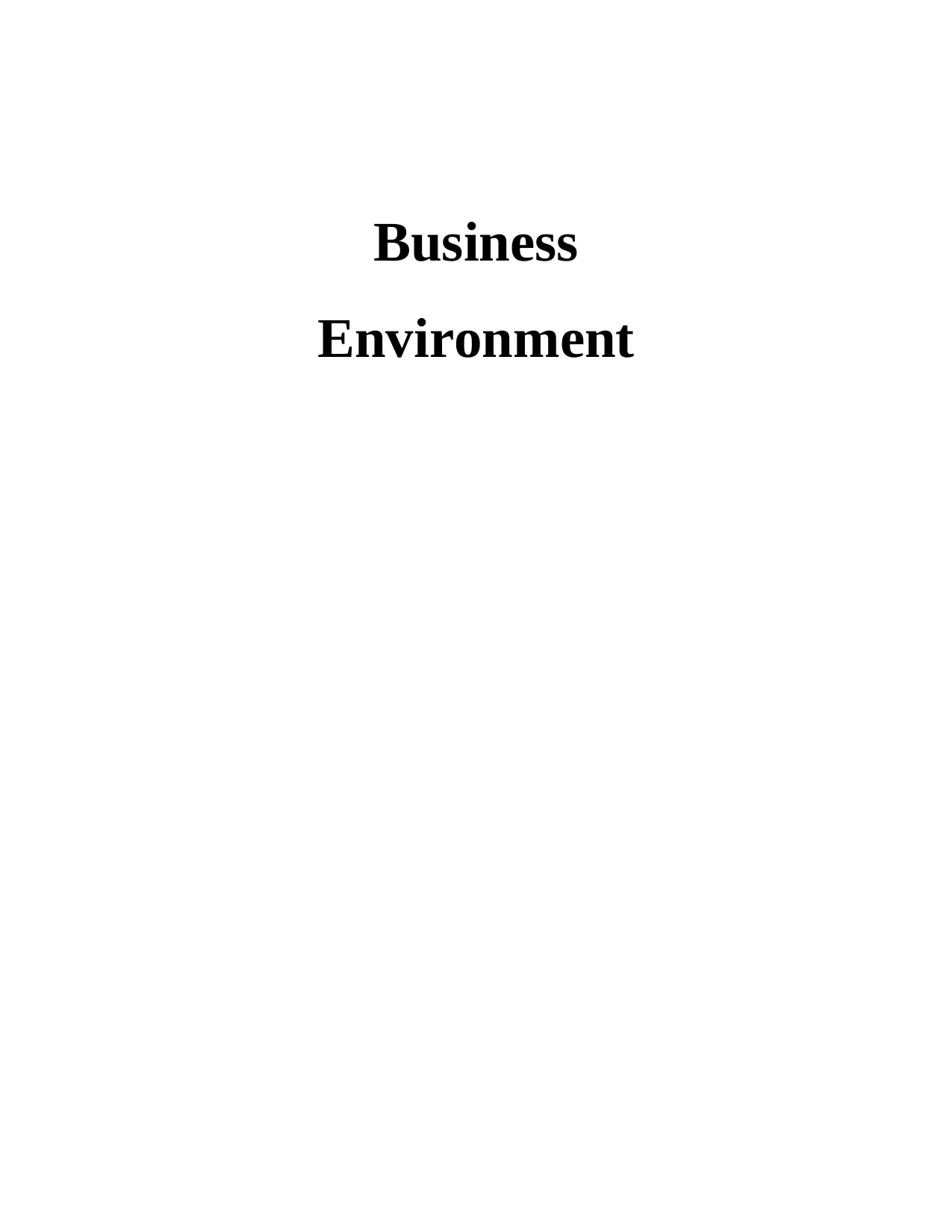
Business
Environment
Environment
Paraphrase This Document
Need a fresh take? Get an instant paraphrase of this document with our AI Paraphraser
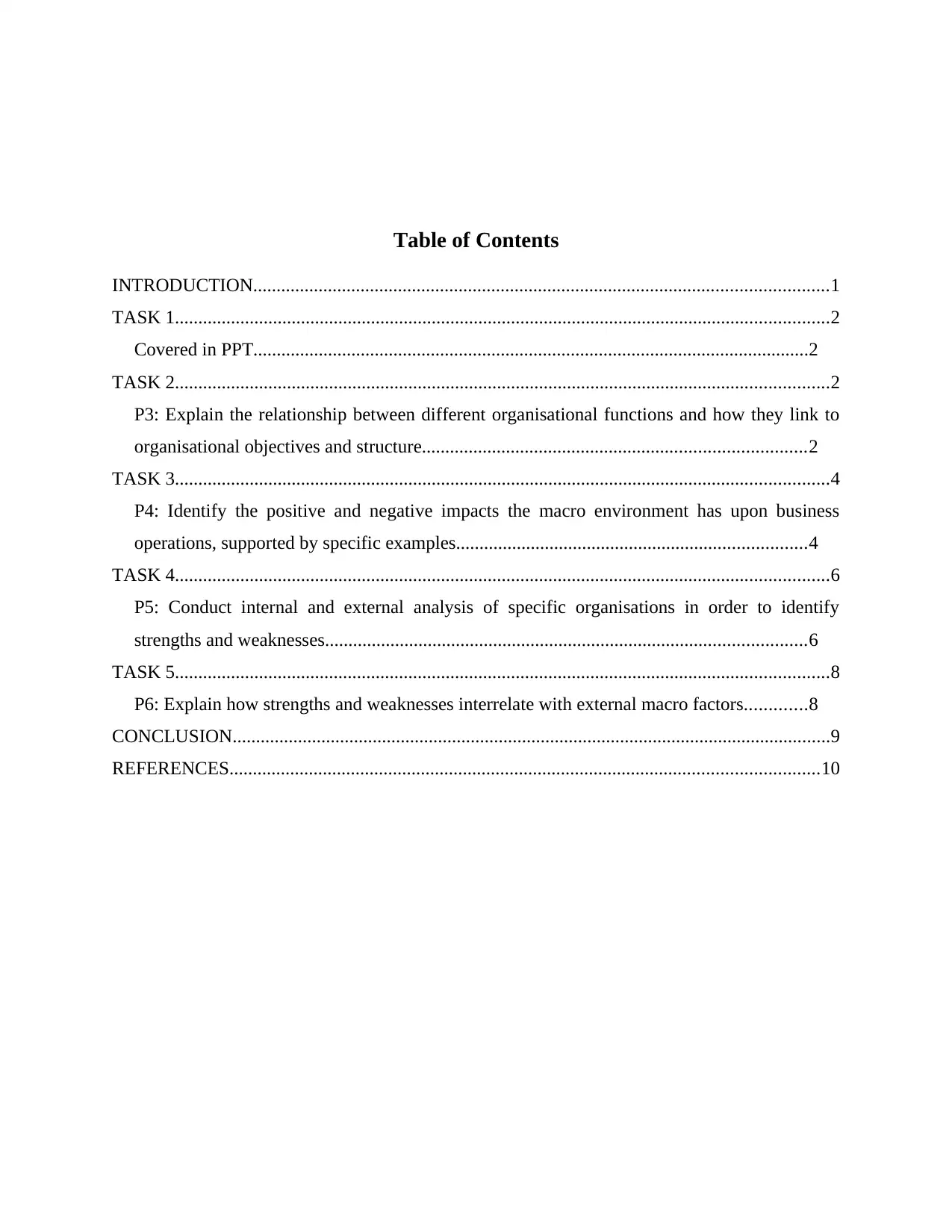
Table of Contents
INTRODUCTION...........................................................................................................................1
TASK 1............................................................................................................................................2
Covered in PPT.......................................................................................................................2
TASK 2............................................................................................................................................2
P3: Explain the relationship between different organisational functions and how they link to
organisational objectives and structure..................................................................................2
TASK 3............................................................................................................................................4
P4: Identify the positive and negative impacts the macro environment has upon business
operations, supported by specific examples...........................................................................4
TASK 4............................................................................................................................................6
P5: Conduct internal and external analysis of specific organisations in order to identify
strengths and weaknesses.......................................................................................................6
TASK 5............................................................................................................................................8
P6: Explain how strengths and weaknesses interrelate with external macro factors.............8
CONCLUSION................................................................................................................................9
REFERENCES..............................................................................................................................10
INTRODUCTION...........................................................................................................................1
TASK 1............................................................................................................................................2
Covered in PPT.......................................................................................................................2
TASK 2............................................................................................................................................2
P3: Explain the relationship between different organisational functions and how they link to
organisational objectives and structure..................................................................................2
TASK 3............................................................................................................................................4
P4: Identify the positive and negative impacts the macro environment has upon business
operations, supported by specific examples...........................................................................4
TASK 4............................................................................................................................................6
P5: Conduct internal and external analysis of specific organisations in order to identify
strengths and weaknesses.......................................................................................................6
TASK 5............................................................................................................................................8
P6: Explain how strengths and weaknesses interrelate with external macro factors.............8
CONCLUSION................................................................................................................................9
REFERENCES..............................................................................................................................10
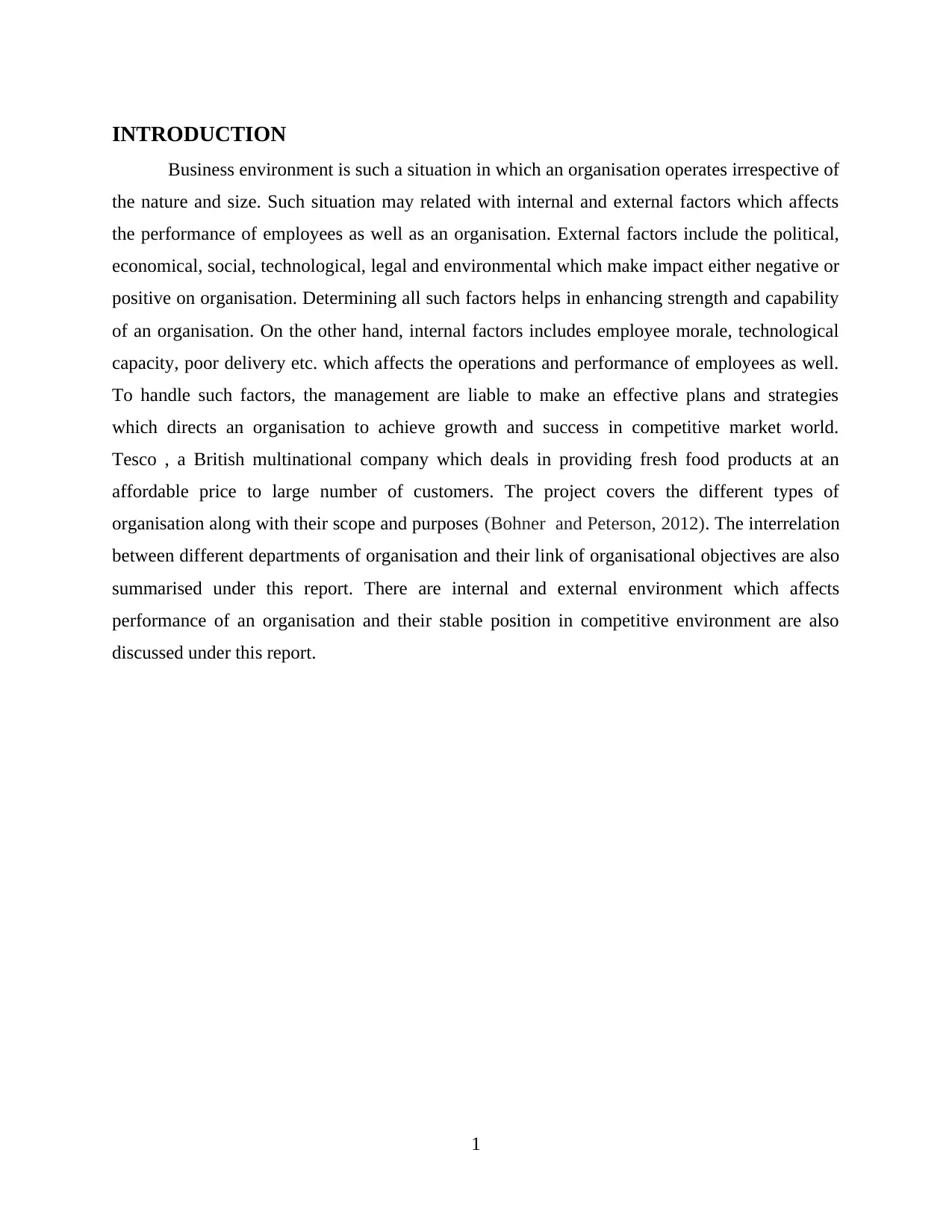
INTRODUCTION
Business environment is such a situation in which an organisation operates irrespective of
the nature and size. Such situation may related with internal and external factors which affects
the performance of employees as well as an organisation. External factors include the political,
economical, social, technological, legal and environmental which make impact either negative or
positive on organisation. Determining all such factors helps in enhancing strength and capability
of an organisation. On the other hand, internal factors includes employee morale, technological
capacity, poor delivery etc. which affects the operations and performance of employees as well.
To handle such factors, the management are liable to make an effective plans and strategies
which directs an organisation to achieve growth and success in competitive market world.
Tesco , a British multinational company which deals in providing fresh food products at an
affordable price to large number of customers. The project covers the different types of
organisation along with their scope and purposes (Bohner and Peterson, 2012). The interrelation
between different departments of organisation and their link of organisational objectives are also
summarised under this report. There are internal and external environment which affects
performance of an organisation and their stable position in competitive environment are also
discussed under this report.
1
Business environment is such a situation in which an organisation operates irrespective of
the nature and size. Such situation may related with internal and external factors which affects
the performance of employees as well as an organisation. External factors include the political,
economical, social, technological, legal and environmental which make impact either negative or
positive on organisation. Determining all such factors helps in enhancing strength and capability
of an organisation. On the other hand, internal factors includes employee morale, technological
capacity, poor delivery etc. which affects the operations and performance of employees as well.
To handle such factors, the management are liable to make an effective plans and strategies
which directs an organisation to achieve growth and success in competitive market world.
Tesco , a British multinational company which deals in providing fresh food products at an
affordable price to large number of customers. The project covers the different types of
organisation along with their scope and purposes (Bohner and Peterson, 2012). The interrelation
between different departments of organisation and their link of organisational objectives are also
summarised under this report. There are internal and external environment which affects
performance of an organisation and their stable position in competitive environment are also
discussed under this report.
1
⊘ This is a preview!⊘
Do you want full access?
Subscribe today to unlock all pages.

Trusted by 1+ million students worldwide
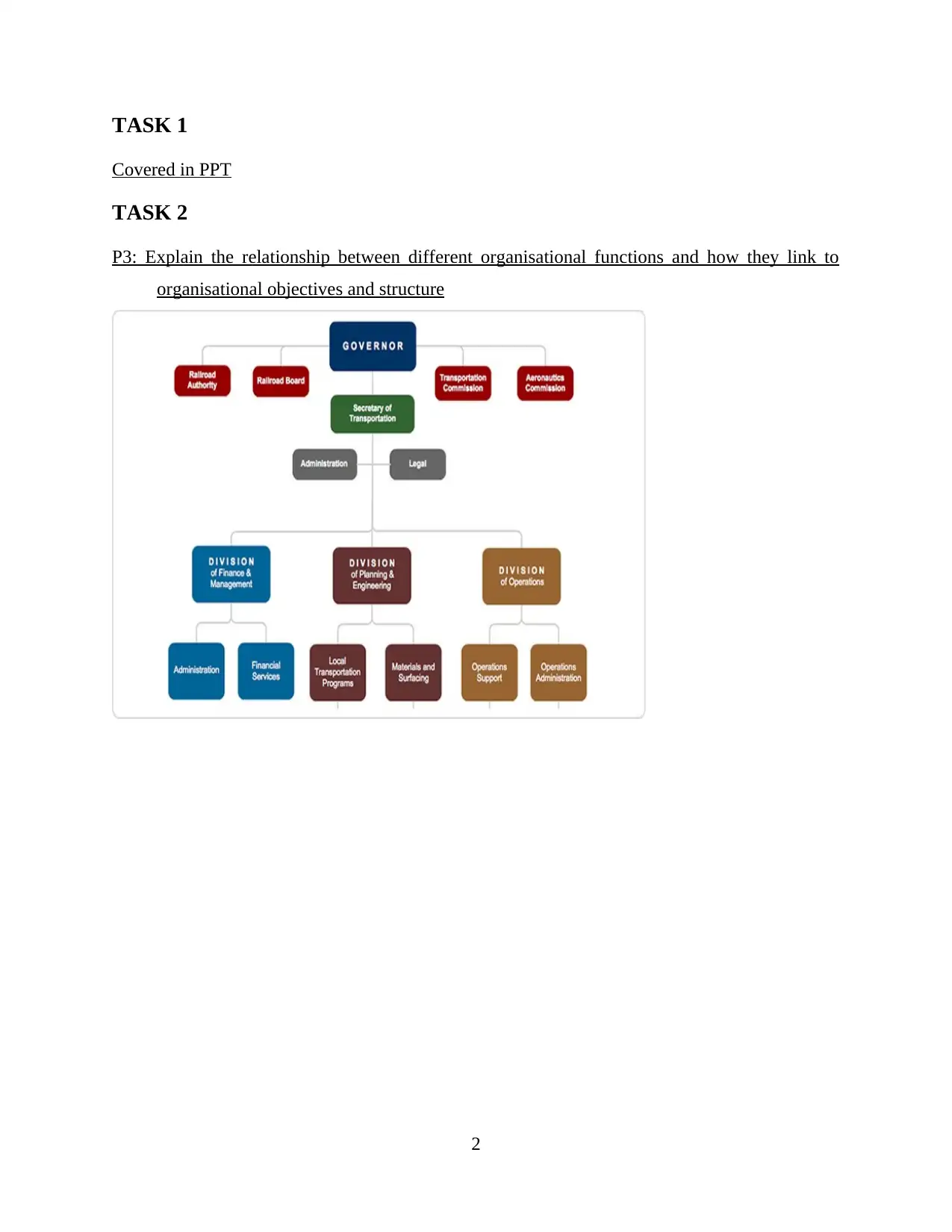
TASK 1
Covered in PPT
TASK 2
P3: Explain the relationship between different organisational functions and how they link to
organisational objectives and structure
2
Covered in PPT
TASK 2
P3: Explain the relationship between different organisational functions and how they link to
organisational objectives and structure
2
Paraphrase This Document
Need a fresh take? Get an instant paraphrase of this document with our AI Paraphraser
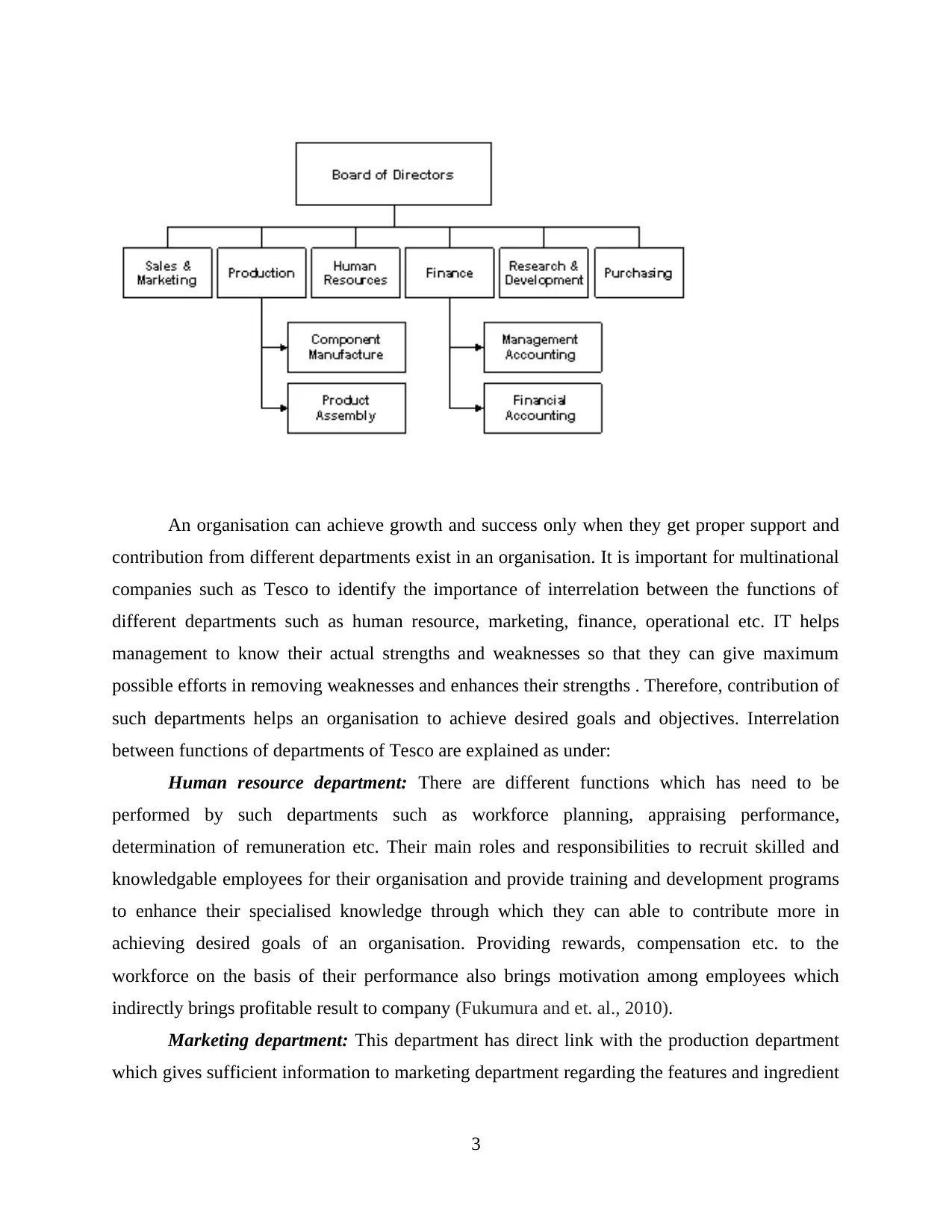
An organisation can achieve growth and success only when they get proper support and
contribution from different departments exist in an organisation. It is important for multinational
companies such as Tesco to identify the importance of interrelation between the functions of
different departments such as human resource, marketing, finance, operational etc. IT helps
management to know their actual strengths and weaknesses so that they can give maximum
possible efforts in removing weaknesses and enhances their strengths . Therefore, contribution of
such departments helps an organisation to achieve desired goals and objectives. Interrelation
between functions of departments of Tesco are explained as under:
Human resource department: There are different functions which has need to be
performed by such departments such as workforce planning, appraising performance,
determination of remuneration etc. Their main roles and responsibilities to recruit skilled and
knowledgable employees for their organisation and provide training and development programs
to enhance their specialised knowledge through which they can able to contribute more in
achieving desired goals of an organisation. Providing rewards, compensation etc. to the
workforce on the basis of their performance also brings motivation among employees which
indirectly brings profitable result to company (Fukumura and et. al., 2010).
Marketing department: This department has direct link with the production department
which gives sufficient information to marketing department regarding the features and ingredient
3
contribution from different departments exist in an organisation. It is important for multinational
companies such as Tesco to identify the importance of interrelation between the functions of
different departments such as human resource, marketing, finance, operational etc. IT helps
management to know their actual strengths and weaknesses so that they can give maximum
possible efforts in removing weaknesses and enhances their strengths . Therefore, contribution of
such departments helps an organisation to achieve desired goals and objectives. Interrelation
between functions of departments of Tesco are explained as under:
Human resource department: There are different functions which has need to be
performed by such departments such as workforce planning, appraising performance,
determination of remuneration etc. Their main roles and responsibilities to recruit skilled and
knowledgable employees for their organisation and provide training and development programs
to enhance their specialised knowledge through which they can able to contribute more in
achieving desired goals of an organisation. Providing rewards, compensation etc. to the
workforce on the basis of their performance also brings motivation among employees which
indirectly brings profitable result to company (Fukumura and et. al., 2010).
Marketing department: This department has direct link with the production department
which gives sufficient information to marketing department regarding the features and ingredient
3
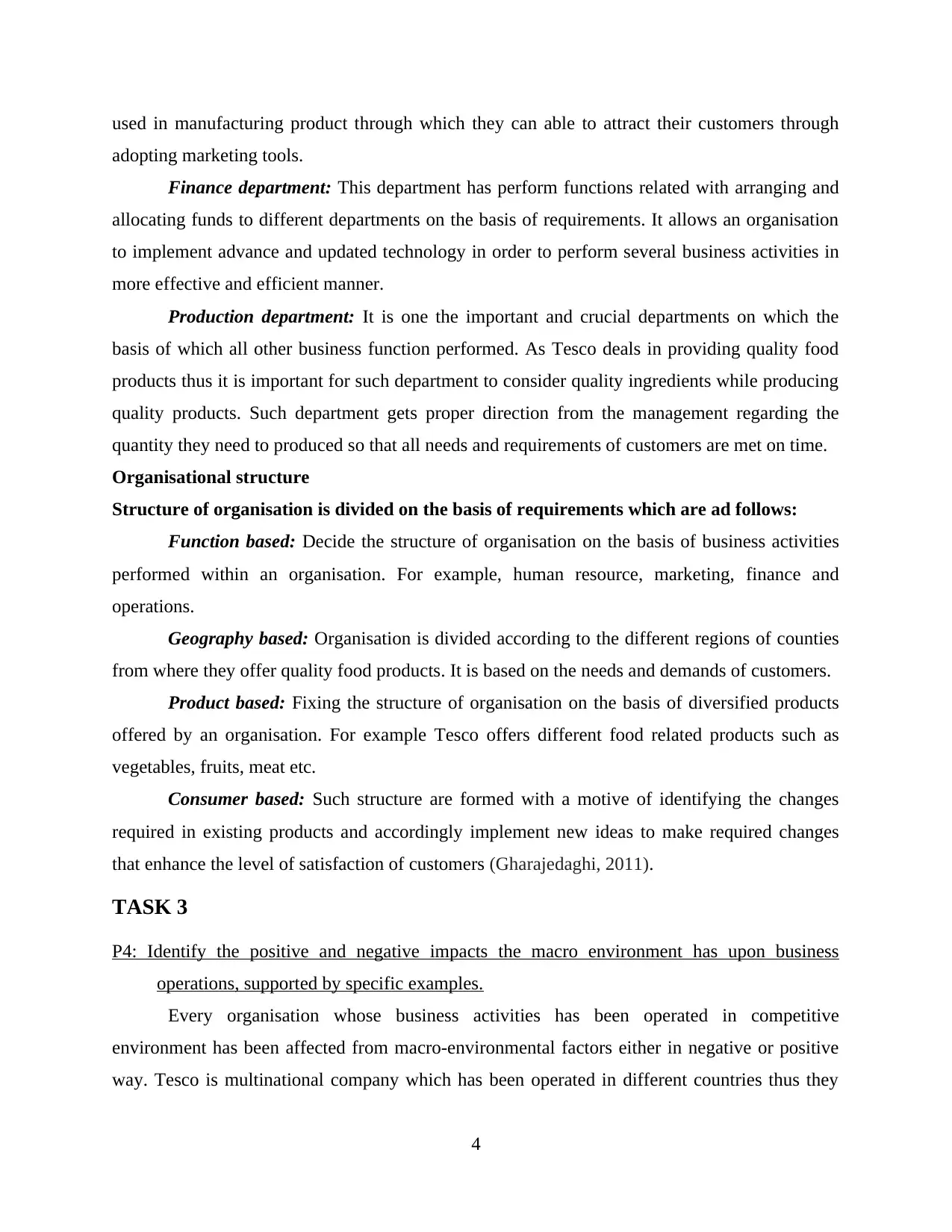
used in manufacturing product through which they can able to attract their customers through
adopting marketing tools.
Finance department: This department has perform functions related with arranging and
allocating funds to different departments on the basis of requirements. It allows an organisation
to implement advance and updated technology in order to perform several business activities in
more effective and efficient manner.
Production department: It is one the important and crucial departments on which the
basis of which all other business function performed. As Tesco deals in providing quality food
products thus it is important for such department to consider quality ingredients while producing
quality products. Such department gets proper direction from the management regarding the
quantity they need to produced so that all needs and requirements of customers are met on time.
Organisational structure
Structure of organisation is divided on the basis of requirements which are ad follows:
Function based: Decide the structure of organisation on the basis of business activities
performed within an organisation. For example, human resource, marketing, finance and
operations.
Geography based: Organisation is divided according to the different regions of counties
from where they offer quality food products. It is based on the needs and demands of customers.
Product based: Fixing the structure of organisation on the basis of diversified products
offered by an organisation. For example Tesco offers different food related products such as
vegetables, fruits, meat etc.
Consumer based: Such structure are formed with a motive of identifying the changes
required in existing products and accordingly implement new ideas to make required changes
that enhance the level of satisfaction of customers (Gharajedaghi, 2011).
TASK 3
P4: Identify the positive and negative impacts the macro environment has upon business
operations, supported by specific examples.
Every organisation whose business activities has been operated in competitive
environment has been affected from macro-environmental factors either in negative or positive
way. Tesco is multinational company which has been operated in different countries thus they
4
adopting marketing tools.
Finance department: This department has perform functions related with arranging and
allocating funds to different departments on the basis of requirements. It allows an organisation
to implement advance and updated technology in order to perform several business activities in
more effective and efficient manner.
Production department: It is one the important and crucial departments on which the
basis of which all other business function performed. As Tesco deals in providing quality food
products thus it is important for such department to consider quality ingredients while producing
quality products. Such department gets proper direction from the management regarding the
quantity they need to produced so that all needs and requirements of customers are met on time.
Organisational structure
Structure of organisation is divided on the basis of requirements which are ad follows:
Function based: Decide the structure of organisation on the basis of business activities
performed within an organisation. For example, human resource, marketing, finance and
operations.
Geography based: Organisation is divided according to the different regions of counties
from where they offer quality food products. It is based on the needs and demands of customers.
Product based: Fixing the structure of organisation on the basis of diversified products
offered by an organisation. For example Tesco offers different food related products such as
vegetables, fruits, meat etc.
Consumer based: Such structure are formed with a motive of identifying the changes
required in existing products and accordingly implement new ideas to make required changes
that enhance the level of satisfaction of customers (Gharajedaghi, 2011).
TASK 3
P4: Identify the positive and negative impacts the macro environment has upon business
operations, supported by specific examples.
Every organisation whose business activities has been operated in competitive
environment has been affected from macro-environmental factors either in negative or positive
way. Tesco is multinational company which has been operated in different countries thus they
4
⊘ This is a preview!⊘
Do you want full access?
Subscribe today to unlock all pages.

Trusted by 1+ million students worldwide
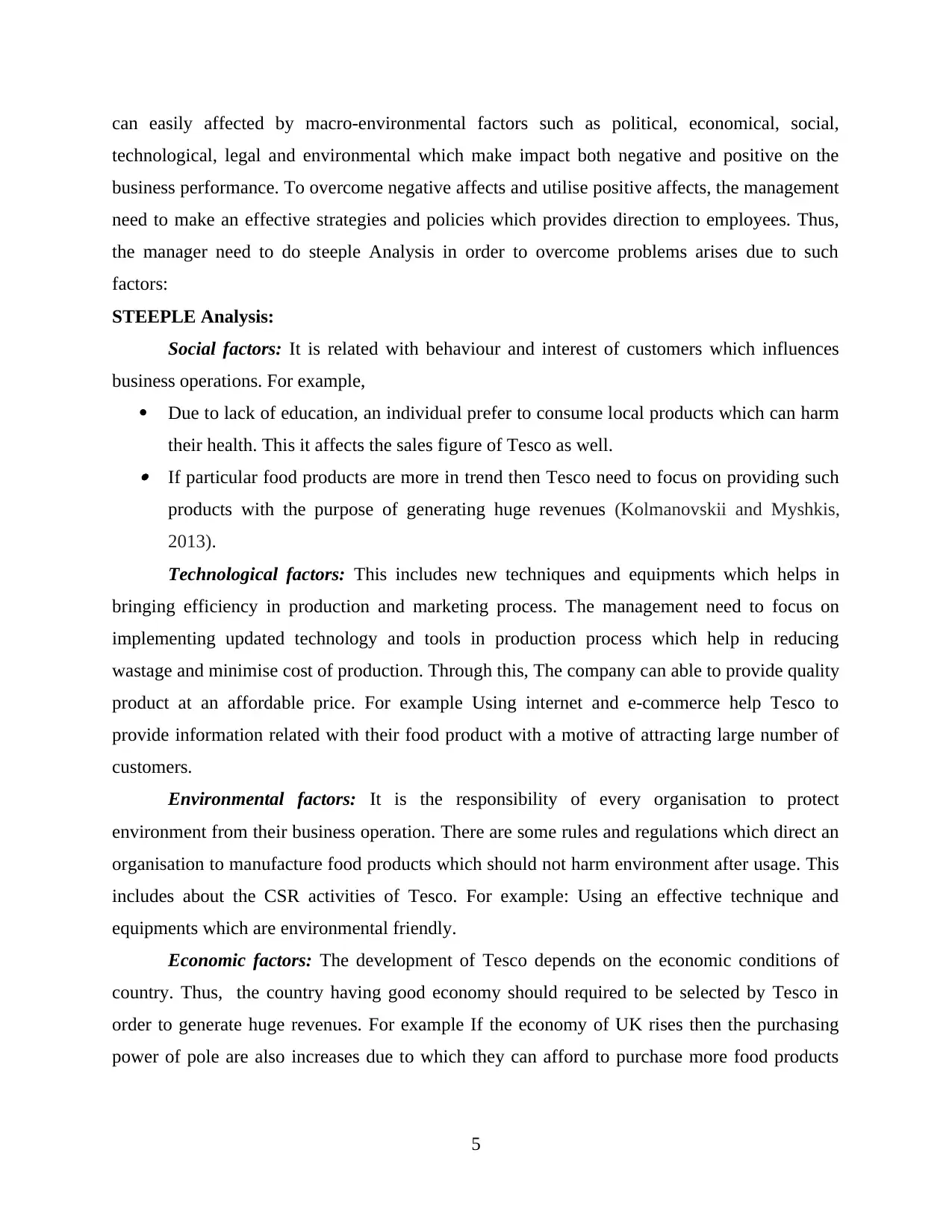
can easily affected by macro-environmental factors such as political, economical, social,
technological, legal and environmental which make impact both negative and positive on the
business performance. To overcome negative affects and utilise positive affects, the management
need to make an effective strategies and policies which provides direction to employees. Thus,
the manager need to do steeple Analysis in order to overcome problems arises due to such
factors:
STEEPLE Analysis:
Social factors: It is related with behaviour and interest of customers which influences
business operations. For example,
Due to lack of education, an individual prefer to consume local products which can harm
their health. This it affects the sales figure of Tesco as well. If particular food products are more in trend then Tesco need to focus on providing such
products with the purpose of generating huge revenues (Kolmanovskii and Myshkis,
2013).
Technological factors: This includes new techniques and equipments which helps in
bringing efficiency in production and marketing process. The management need to focus on
implementing updated technology and tools in production process which help in reducing
wastage and minimise cost of production. Through this, The company can able to provide quality
product at an affordable price. For example Using internet and e-commerce help Tesco to
provide information related with their food product with a motive of attracting large number of
customers.
Environmental factors: It is the responsibility of every organisation to protect
environment from their business operation. There are some rules and regulations which direct an
organisation to manufacture food products which should not harm environment after usage. This
includes about the CSR activities of Tesco. For example: Using an effective technique and
equipments which are environmental friendly.
Economic factors: The development of Tesco depends on the economic conditions of
country. Thus, the country having good economy should required to be selected by Tesco in
order to generate huge revenues. For example If the economy of UK rises then the purchasing
power of pole are also increases due to which they can afford to purchase more food products
5
technological, legal and environmental which make impact both negative and positive on the
business performance. To overcome negative affects and utilise positive affects, the management
need to make an effective strategies and policies which provides direction to employees. Thus,
the manager need to do steeple Analysis in order to overcome problems arises due to such
factors:
STEEPLE Analysis:
Social factors: It is related with behaviour and interest of customers which influences
business operations. For example,
Due to lack of education, an individual prefer to consume local products which can harm
their health. This it affects the sales figure of Tesco as well. If particular food products are more in trend then Tesco need to focus on providing such
products with the purpose of generating huge revenues (Kolmanovskii and Myshkis,
2013).
Technological factors: This includes new techniques and equipments which helps in
bringing efficiency in production and marketing process. The management need to focus on
implementing updated technology and tools in production process which help in reducing
wastage and minimise cost of production. Through this, The company can able to provide quality
product at an affordable price. For example Using internet and e-commerce help Tesco to
provide information related with their food product with a motive of attracting large number of
customers.
Environmental factors: It is the responsibility of every organisation to protect
environment from their business operation. There are some rules and regulations which direct an
organisation to manufacture food products which should not harm environment after usage. This
includes about the CSR activities of Tesco. For example: Using an effective technique and
equipments which are environmental friendly.
Economic factors: The development of Tesco depends on the economic conditions of
country. Thus, the country having good economy should required to be selected by Tesco in
order to generate huge revenues. For example If the economy of UK rises then the purchasing
power of pole are also increases due to which they can afford to purchase more food products
5
Paraphrase This Document
Need a fresh take? Get an instant paraphrase of this document with our AI Paraphraser
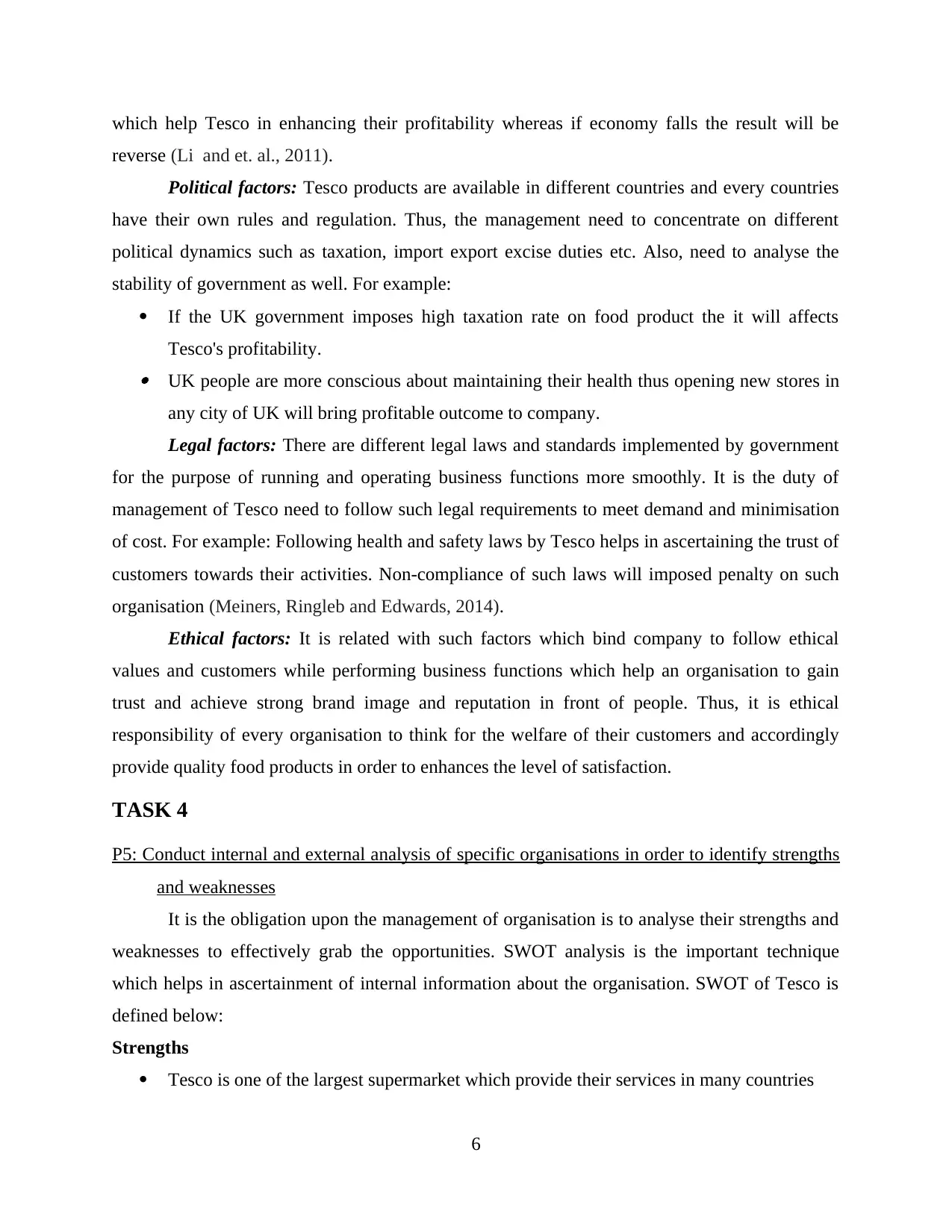
which help Tesco in enhancing their profitability whereas if economy falls the result will be
reverse (Li and et. al., 2011).
Political factors: Tesco products are available in different countries and every countries
have their own rules and regulation. Thus, the management need to concentrate on different
political dynamics such as taxation, import export excise duties etc. Also, need to analyse the
stability of government as well. For example:
If the UK government imposes high taxation rate on food product the it will affects
Tesco's profitability. UK people are more conscious about maintaining their health thus opening new stores in
any city of UK will bring profitable outcome to company.
Legal factors: There are different legal laws and standards implemented by government
for the purpose of running and operating business functions more smoothly. It is the duty of
management of Tesco need to follow such legal requirements to meet demand and minimisation
of cost. For example: Following health and safety laws by Tesco helps in ascertaining the trust of
customers towards their activities. Non-compliance of such laws will imposed penalty on such
organisation (Meiners, Ringleb and Edwards, 2014).
Ethical factors: It is related with such factors which bind company to follow ethical
values and customers while performing business functions which help an organisation to gain
trust and achieve strong brand image and reputation in front of people. Thus, it is ethical
responsibility of every organisation to think for the welfare of their customers and accordingly
provide quality food products in order to enhances the level of satisfaction.
TASK 4
P5: Conduct internal and external analysis of specific organisations in order to identify strengths
and weaknesses
It is the obligation upon the management of organisation is to analyse their strengths and
weaknesses to effectively grab the opportunities. SWOT analysis is the important technique
which helps in ascertainment of internal information about the organisation. SWOT of Tesco is
defined below:
Strengths
Tesco is one of the largest supermarket which provide their services in many countries
6
reverse (Li and et. al., 2011).
Political factors: Tesco products are available in different countries and every countries
have their own rules and regulation. Thus, the management need to concentrate on different
political dynamics such as taxation, import export excise duties etc. Also, need to analyse the
stability of government as well. For example:
If the UK government imposes high taxation rate on food product the it will affects
Tesco's profitability. UK people are more conscious about maintaining their health thus opening new stores in
any city of UK will bring profitable outcome to company.
Legal factors: There are different legal laws and standards implemented by government
for the purpose of running and operating business functions more smoothly. It is the duty of
management of Tesco need to follow such legal requirements to meet demand and minimisation
of cost. For example: Following health and safety laws by Tesco helps in ascertaining the trust of
customers towards their activities. Non-compliance of such laws will imposed penalty on such
organisation (Meiners, Ringleb and Edwards, 2014).
Ethical factors: It is related with such factors which bind company to follow ethical
values and customers while performing business functions which help an organisation to gain
trust and achieve strong brand image and reputation in front of people. Thus, it is ethical
responsibility of every organisation to think for the welfare of their customers and accordingly
provide quality food products in order to enhances the level of satisfaction.
TASK 4
P5: Conduct internal and external analysis of specific organisations in order to identify strengths
and weaknesses
It is the obligation upon the management of organisation is to analyse their strengths and
weaknesses to effectively grab the opportunities. SWOT analysis is the important technique
which helps in ascertainment of internal information about the organisation. SWOT of Tesco is
defined below:
Strengths
Tesco is one of the largest supermarket which provide their services in many countries
6
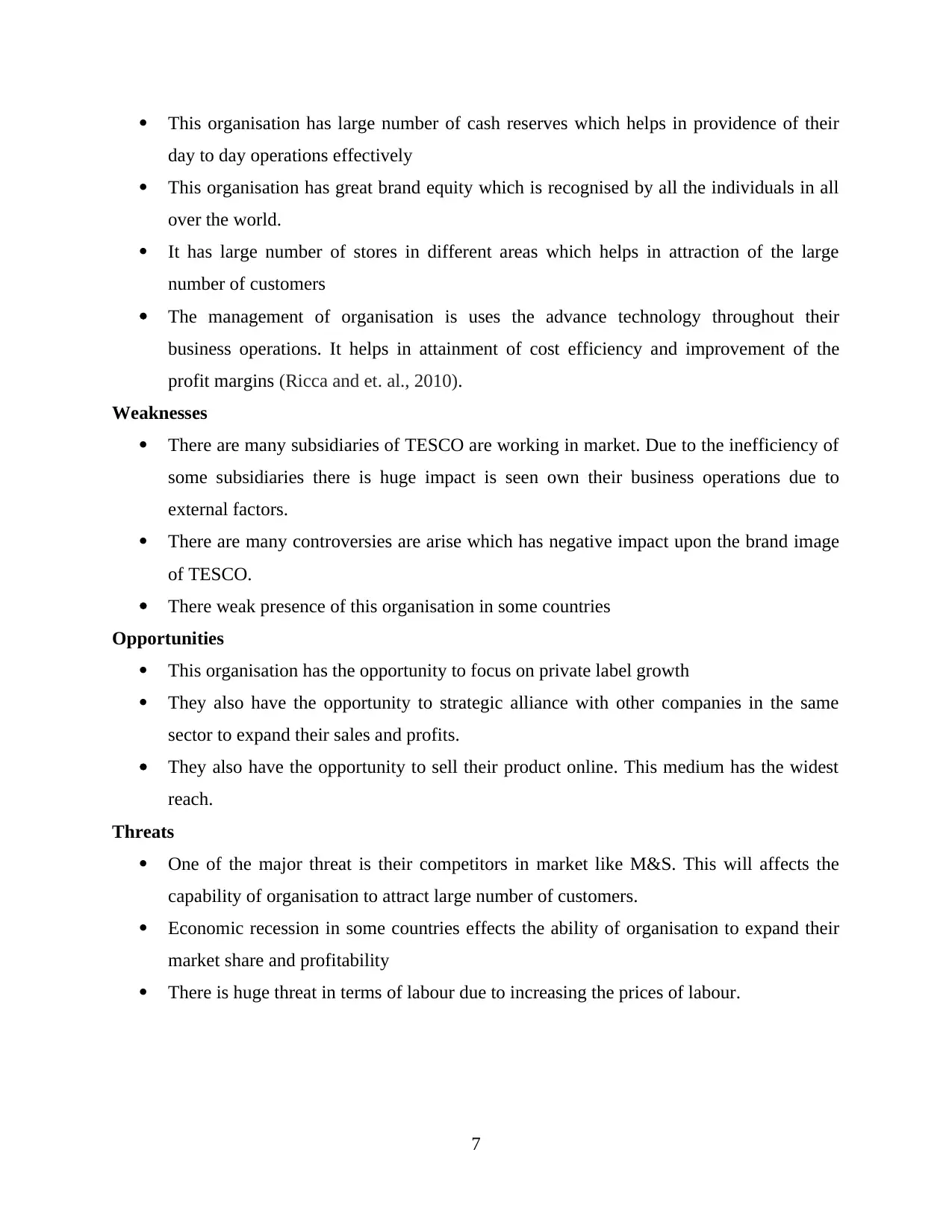
This organisation has large number of cash reserves which helps in providence of their
day to day operations effectively
This organisation has great brand equity which is recognised by all the individuals in all
over the world.
It has large number of stores in different areas which helps in attraction of the large
number of customers
The management of organisation is uses the advance technology throughout their
business operations. It helps in attainment of cost efficiency and improvement of the
profit margins (Ricca and et. al., 2010).
Weaknesses
There are many subsidiaries of TESCO are working in market. Due to the inefficiency of
some subsidiaries there is huge impact is seen own their business operations due to
external factors.
There are many controversies are arise which has negative impact upon the brand image
of TESCO.
There weak presence of this organisation in some countries
Opportunities
This organisation has the opportunity to focus on private label growth
They also have the opportunity to strategic alliance with other companies in the same
sector to expand their sales and profits.
They also have the opportunity to sell their product online. This medium has the widest
reach.
Threats
One of the major threat is their competitors in market like M&S. This will affects the
capability of organisation to attract large number of customers.
Economic recession in some countries effects the ability of organisation to expand their
market share and profitability
There is huge threat in terms of labour due to increasing the prices of labour.
7
day to day operations effectively
This organisation has great brand equity which is recognised by all the individuals in all
over the world.
It has large number of stores in different areas which helps in attraction of the large
number of customers
The management of organisation is uses the advance technology throughout their
business operations. It helps in attainment of cost efficiency and improvement of the
profit margins (Ricca and et. al., 2010).
Weaknesses
There are many subsidiaries of TESCO are working in market. Due to the inefficiency of
some subsidiaries there is huge impact is seen own their business operations due to
external factors.
There are many controversies are arise which has negative impact upon the brand image
of TESCO.
There weak presence of this organisation in some countries
Opportunities
This organisation has the opportunity to focus on private label growth
They also have the opportunity to strategic alliance with other companies in the same
sector to expand their sales and profits.
They also have the opportunity to sell their product online. This medium has the widest
reach.
Threats
One of the major threat is their competitors in market like M&S. This will affects the
capability of organisation to attract large number of customers.
Economic recession in some countries effects the ability of organisation to expand their
market share and profitability
There is huge threat in terms of labour due to increasing the prices of labour.
7
⊘ This is a preview!⊘
Do you want full access?
Subscribe today to unlock all pages.

Trusted by 1+ million students worldwide
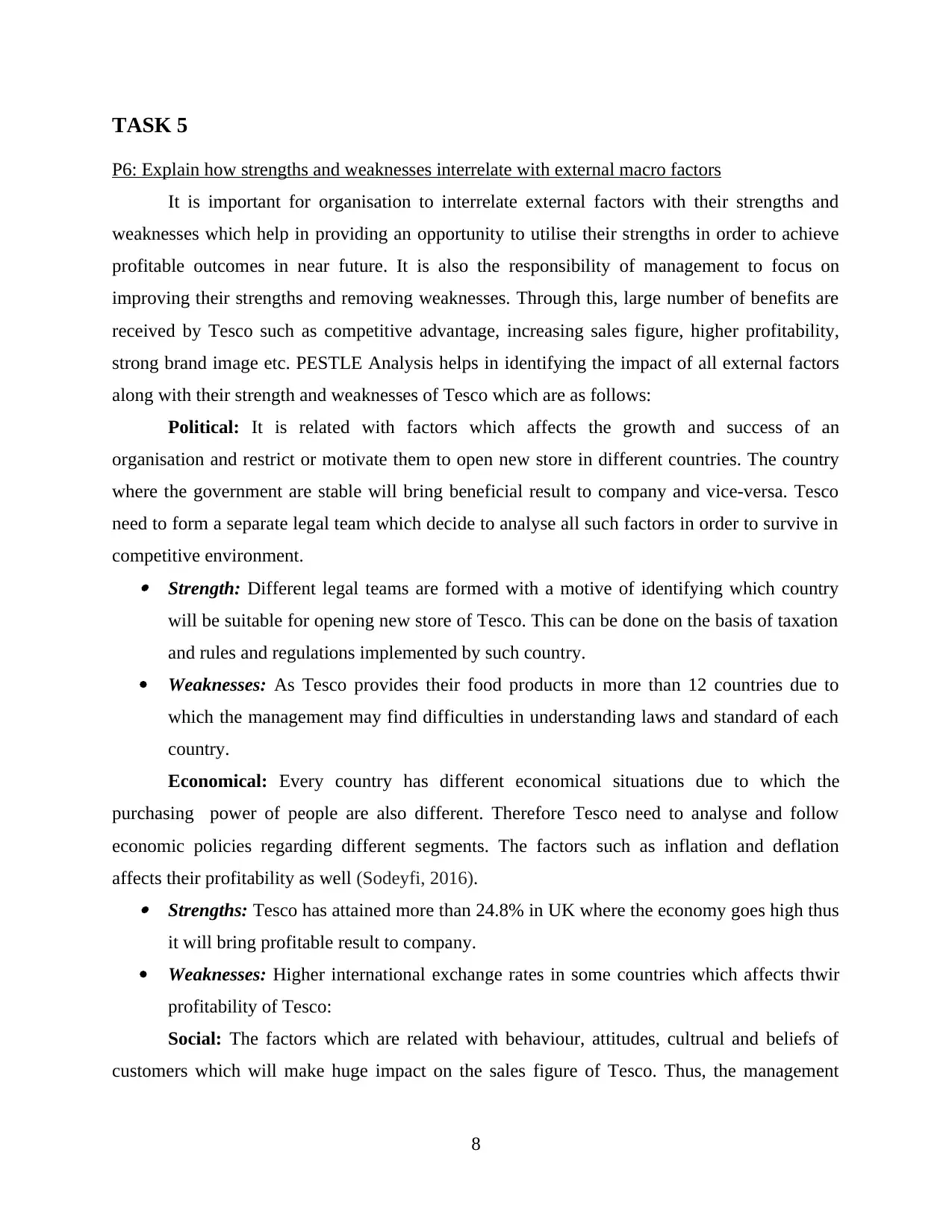
TASK 5
P6: Explain how strengths and weaknesses interrelate with external macro factors
It is important for organisation to interrelate external factors with their strengths and
weaknesses which help in providing an opportunity to utilise their strengths in order to achieve
profitable outcomes in near future. It is also the responsibility of management to focus on
improving their strengths and removing weaknesses. Through this, large number of benefits are
received by Tesco such as competitive advantage, increasing sales figure, higher profitability,
strong brand image etc. PESTLE Analysis helps in identifying the impact of all external factors
along with their strength and weaknesses of Tesco which are as follows:
Political: It is related with factors which affects the growth and success of an
organisation and restrict or motivate them to open new store in different countries. The country
where the government are stable will bring beneficial result to company and vice-versa. Tesco
need to form a separate legal team which decide to analyse all such factors in order to survive in
competitive environment. Strength: Different legal teams are formed with a motive of identifying which country
will be suitable for opening new store of Tesco. This can be done on the basis of taxation
and rules and regulations implemented by such country.
Weaknesses: As Tesco provides their food products in more than 12 countries due to
which the management may find difficulties in understanding laws and standard of each
country.
Economical: Every country has different economical situations due to which the
purchasing power of people are also different. Therefore Tesco need to analyse and follow
economic policies regarding different segments. The factors such as inflation and deflation
affects their profitability as well (Sodeyfi, 2016). Strengths: Tesco has attained more than 24.8% in UK where the economy goes high thus
it will bring profitable result to company.
Weaknesses: Higher international exchange rates in some countries which affects thwir
profitability of Tesco:
Social: The factors which are related with behaviour, attitudes, cultrual and beliefs of
customers which will make huge impact on the sales figure of Tesco. Thus, the management
8
P6: Explain how strengths and weaknesses interrelate with external macro factors
It is important for organisation to interrelate external factors with their strengths and
weaknesses which help in providing an opportunity to utilise their strengths in order to achieve
profitable outcomes in near future. It is also the responsibility of management to focus on
improving their strengths and removing weaknesses. Through this, large number of benefits are
received by Tesco such as competitive advantage, increasing sales figure, higher profitability,
strong brand image etc. PESTLE Analysis helps in identifying the impact of all external factors
along with their strength and weaknesses of Tesco which are as follows:
Political: It is related with factors which affects the growth and success of an
organisation and restrict or motivate them to open new store in different countries. The country
where the government are stable will bring beneficial result to company and vice-versa. Tesco
need to form a separate legal team which decide to analyse all such factors in order to survive in
competitive environment. Strength: Different legal teams are formed with a motive of identifying which country
will be suitable for opening new store of Tesco. This can be done on the basis of taxation
and rules and regulations implemented by such country.
Weaknesses: As Tesco provides their food products in more than 12 countries due to
which the management may find difficulties in understanding laws and standard of each
country.
Economical: Every country has different economical situations due to which the
purchasing power of people are also different. Therefore Tesco need to analyse and follow
economic policies regarding different segments. The factors such as inflation and deflation
affects their profitability as well (Sodeyfi, 2016). Strengths: Tesco has attained more than 24.8% in UK where the economy goes high thus
it will bring profitable result to company.
Weaknesses: Higher international exchange rates in some countries which affects thwir
profitability of Tesco:
Social: The factors which are related with behaviour, attitudes, cultrual and beliefs of
customers which will make huge impact on the sales figure of Tesco. Thus, the management
8
Paraphrase This Document
Need a fresh take? Get an instant paraphrase of this document with our AI Paraphraser
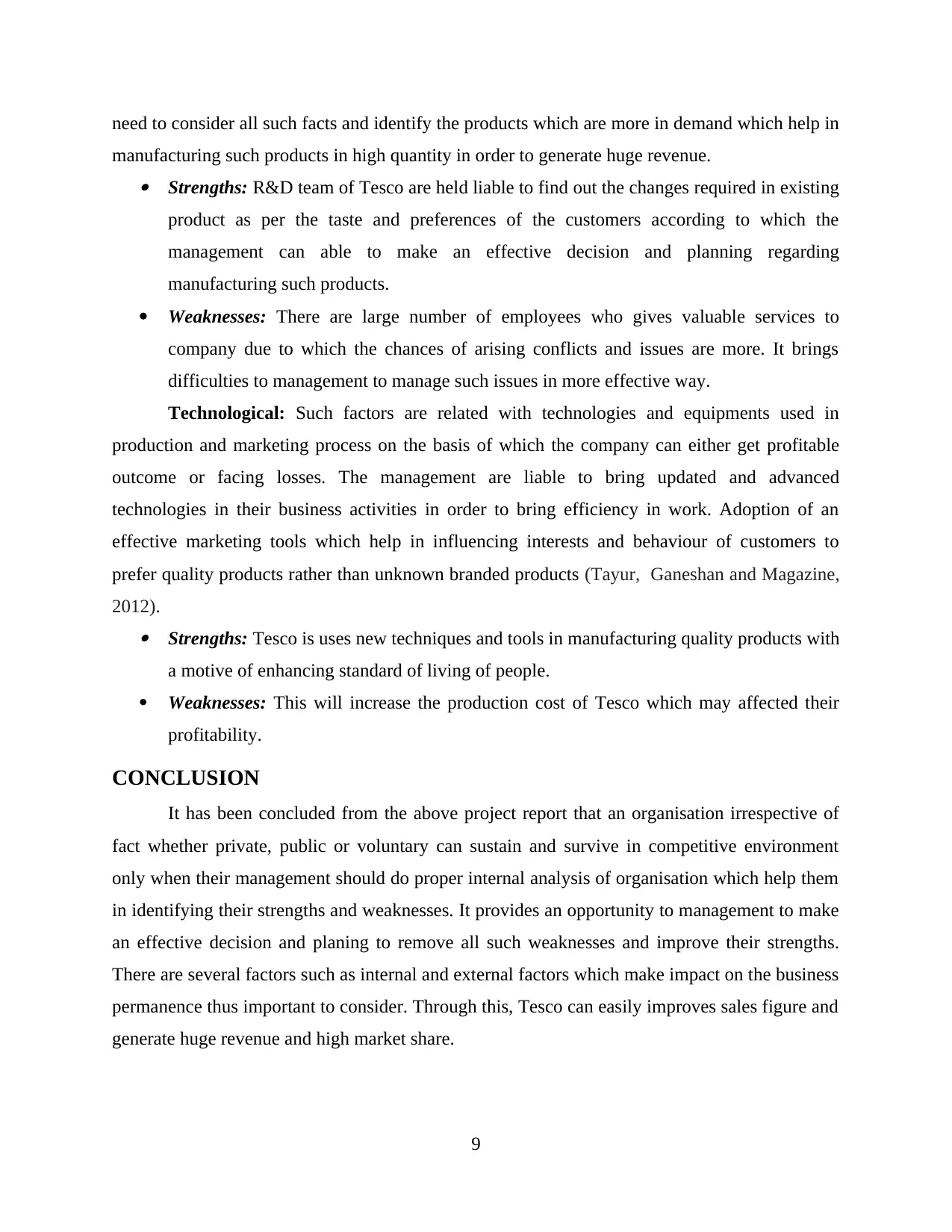
need to consider all such facts and identify the products which are more in demand which help in
manufacturing such products in high quantity in order to generate huge revenue. Strengths: R&D team of Tesco are held liable to find out the changes required in existing
product as per the taste and preferences of the customers according to which the
management can able to make an effective decision and planning regarding
manufacturing such products.
Weaknesses: There are large number of employees who gives valuable services to
company due to which the chances of arising conflicts and issues are more. It brings
difficulties to management to manage such issues in more effective way.
Technological: Such factors are related with technologies and equipments used in
production and marketing process on the basis of which the company can either get profitable
outcome or facing losses. The management are liable to bring updated and advanced
technologies in their business activities in order to bring efficiency in work. Adoption of an
effective marketing tools which help in influencing interests and behaviour of customers to
prefer quality products rather than unknown branded products (Tayur, Ganeshan and Magazine,
2012). Strengths: Tesco is uses new techniques and tools in manufacturing quality products with
a motive of enhancing standard of living of people.
Weaknesses: This will increase the production cost of Tesco which may affected their
profitability.
CONCLUSION
It has been concluded from the above project report that an organisation irrespective of
fact whether private, public or voluntary can sustain and survive in competitive environment
only when their management should do proper internal analysis of organisation which help them
in identifying their strengths and weaknesses. It provides an opportunity to management to make
an effective decision and planing to remove all such weaknesses and improve their strengths.
There are several factors such as internal and external factors which make impact on the business
permanence thus important to consider. Through this, Tesco can easily improves sales figure and
generate huge revenue and high market share.
9
manufacturing such products in high quantity in order to generate huge revenue. Strengths: R&D team of Tesco are held liable to find out the changes required in existing
product as per the taste and preferences of the customers according to which the
management can able to make an effective decision and planning regarding
manufacturing such products.
Weaknesses: There are large number of employees who gives valuable services to
company due to which the chances of arising conflicts and issues are more. It brings
difficulties to management to manage such issues in more effective way.
Technological: Such factors are related with technologies and equipments used in
production and marketing process on the basis of which the company can either get profitable
outcome or facing losses. The management are liable to bring updated and advanced
technologies in their business activities in order to bring efficiency in work. Adoption of an
effective marketing tools which help in influencing interests and behaviour of customers to
prefer quality products rather than unknown branded products (Tayur, Ganeshan and Magazine,
2012). Strengths: Tesco is uses new techniques and tools in manufacturing quality products with
a motive of enhancing standard of living of people.
Weaknesses: This will increase the production cost of Tesco which may affected their
profitability.
CONCLUSION
It has been concluded from the above project report that an organisation irrespective of
fact whether private, public or voluntary can sustain and survive in competitive environment
only when their management should do proper internal analysis of organisation which help them
in identifying their strengths and weaknesses. It provides an opportunity to management to make
an effective decision and planing to remove all such weaknesses and improve their strengths.
There are several factors such as internal and external factors which make impact on the business
permanence thus important to consider. Through this, Tesco can easily improves sales figure and
generate huge revenue and high market share.
9
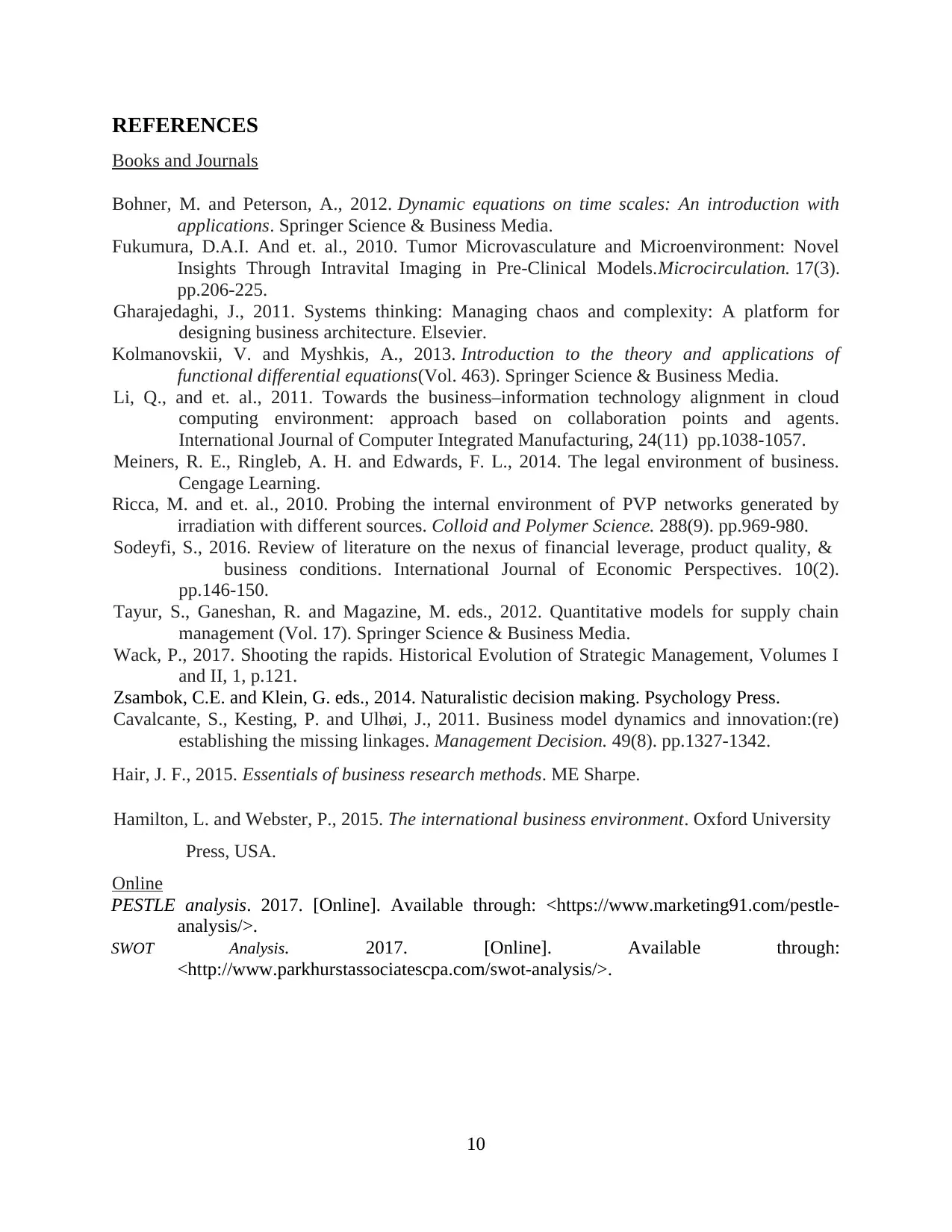
REFERENCES
Books and Journals
Bohner, M. and Peterson, A., 2012. Dynamic equations on time scales: An introduction with
applications. Springer Science & Business Media.
Fukumura, D.A.I. And et. al., 2010. Tumor Microvasculature and Microenvironment: Novel
Insights Through Intravital Imaging in Pre‐Clinical Models.Microcirculation. 17(3).
pp.206-225.
Gharajedaghi, J., 2011. Systems thinking: Managing chaos and complexity: A platform for
designing business architecture. Elsevier.
Kolmanovskii, V. and Myshkis, A., 2013. Introduction to the theory and applications of
functional differential equations(Vol. 463). Springer Science & Business Media.
Li, Q., and et. al., 2011. Towards the business–information technology alignment in cloud
computing environment: approach based on collaboration points and agents.
International Journal of Computer Integrated Manufacturing, 24(11) pp.1038-1057.
Meiners, R. E., Ringleb, A. H. and Edwards, F. L., 2014. The legal environment of business.
Cengage Learning.
Ricca, M. and et. al., 2010. Probing the internal environment of PVP networks generated by
irradiation with different sources. Colloid and Polymer Science. 288(9). pp.969-980.
Sodeyfi, S., 2016. Review of literature on the nexus of financial leverage, product quality, &
business conditions. International Journal of Economic Perspectives. 10(2).
pp.146-150.
Tayur, S., Ganeshan, R. and Magazine, M. eds., 2012. Quantitative models for supply chain
management (Vol. 17). Springer Science & Business Media.
Wack, P., 2017. Shooting the rapids. Historical Evolution of Strategic Management, Volumes I
and II, 1, p.121.
Zsambok, C.E. and Klein, G. eds., 2014. Naturalistic decision making. Psychology Press.
Cavalcante, S., Kesting, P. and Ulhøi, J., 2011. Business model dynamics and innovation:(re)
establishing the missing linkages. Management Decision. 49(8). pp.1327-1342.
Hair, J. F., 2015. Essentials of business research methods. ME Sharpe.
Hamilton, L. and Webster, P., 2015. The international business environment. Oxford University
Press, USA.
Online
PESTLE analysis. 2017. [Online]. Available through: <https://www.marketing91.com/pestle-
analysis/>.
SWOT Analysis. 2017. [Online]. Available through:
<http://www.parkhurstassociatescpa.com/swot-analysis/>.
10
Books and Journals
Bohner, M. and Peterson, A., 2012. Dynamic equations on time scales: An introduction with
applications. Springer Science & Business Media.
Fukumura, D.A.I. And et. al., 2010. Tumor Microvasculature and Microenvironment: Novel
Insights Through Intravital Imaging in Pre‐Clinical Models.Microcirculation. 17(3).
pp.206-225.
Gharajedaghi, J., 2011. Systems thinking: Managing chaos and complexity: A platform for
designing business architecture. Elsevier.
Kolmanovskii, V. and Myshkis, A., 2013. Introduction to the theory and applications of
functional differential equations(Vol. 463). Springer Science & Business Media.
Li, Q., and et. al., 2011. Towards the business–information technology alignment in cloud
computing environment: approach based on collaboration points and agents.
International Journal of Computer Integrated Manufacturing, 24(11) pp.1038-1057.
Meiners, R. E., Ringleb, A. H. and Edwards, F. L., 2014. The legal environment of business.
Cengage Learning.
Ricca, M. and et. al., 2010. Probing the internal environment of PVP networks generated by
irradiation with different sources. Colloid and Polymer Science. 288(9). pp.969-980.
Sodeyfi, S., 2016. Review of literature on the nexus of financial leverage, product quality, &
business conditions. International Journal of Economic Perspectives. 10(2).
pp.146-150.
Tayur, S., Ganeshan, R. and Magazine, M. eds., 2012. Quantitative models for supply chain
management (Vol. 17). Springer Science & Business Media.
Wack, P., 2017. Shooting the rapids. Historical Evolution of Strategic Management, Volumes I
and II, 1, p.121.
Zsambok, C.E. and Klein, G. eds., 2014. Naturalistic decision making. Psychology Press.
Cavalcante, S., Kesting, P. and Ulhøi, J., 2011. Business model dynamics and innovation:(re)
establishing the missing linkages. Management Decision. 49(8). pp.1327-1342.
Hair, J. F., 2015. Essentials of business research methods. ME Sharpe.
Hamilton, L. and Webster, P., 2015. The international business environment. Oxford University
Press, USA.
Online
PESTLE analysis. 2017. [Online]. Available through: <https://www.marketing91.com/pestle-
analysis/>.
SWOT Analysis. 2017. [Online]. Available through:
<http://www.parkhurstassociatescpa.com/swot-analysis/>.
10
⊘ This is a preview!⊘
Do you want full access?
Subscribe today to unlock all pages.

Trusted by 1+ million students worldwide
1 out of 12
Related Documents
Your All-in-One AI-Powered Toolkit for Academic Success.
+13062052269
info@desklib.com
Available 24*7 on WhatsApp / Email
![[object Object]](/_next/static/media/star-bottom.7253800d.svg)
Unlock your academic potential
Copyright © 2020–2025 A2Z Services. All Rights Reserved. Developed and managed by ZUCOL.





